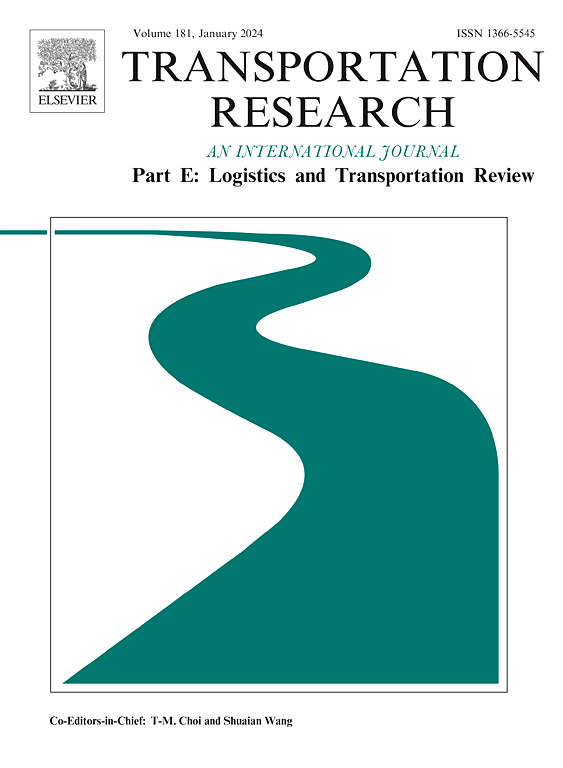Towards advanced decision-making support for shipping safety: A functional connectivity analysis
IF 8.3
1区 工程技术
Q1 ECONOMICS
Transportation Research Part E-Logistics and Transportation Review
Pub Date : 2024-11-17
DOI:10.1016/j.tre.2024.103861
引用次数: 0
Abstract
Decision making (DM) is essential and proven to be a natural and inherent part of the success of transport systems, particularly given the fast growth of autonomous systems in transport. It is critical but remains challenging to understand and predict DM performance in transport, because operators’ mental states have not been effectively considered in complex DM processes such as ship anti-collision operations. This paper proposes an advanced decision support methodology that pioneers the incorporation of objective neurophysiological and subjective data to analyse functional connectivity in the brain and predict DM performance in ship navigation. Experiments were conducted using a functional Near-Infrared Spectroscopy (fNIRS) technology to explore the functional connectivity of two groups (low workload and high workload) and predict their DM performance in a ship collision avoidance situation. It brings brain science into transport engineering and the results generate new contributions to the existing knowledge, including (1) the establishment of a methodology to detect different workload levels in safety–critical transport systems using psychophysiological measurement; (2) analysis of brain’s functional connectivity of different groups of decision makers (e.g., seafarers) with high and low workload tasks; (3) an advanced methodology to assess human reliability in complex scenarios and predict operational behaviours; (4) pioneering a human-centred approach to predict DM performance and demonstrate its feasibility in shipping. From a practical perspective, stakeholders can utilise the findings of this study to rationally evaluate human performance in transport system operations, aiding in operator qualification and certification processes. Furthermore, it is critical for adaptive automation regarding DM support in safety–critical systems.
为航运安全提供高级决策支持:功能连接分析
决策(DM)是运输系统成功的必要条件和固有组成部分,特别是考虑到运输中自主系统的快速发展。由于在复杂的决策制定过程(如船舶防碰撞操作)中,操作员的心理状态尚未得到有效考虑,因此理解和预测运输系统中的决策制定性能至关重要,但仍然具有挑战性。本文提出了一种先进的决策支持方法,率先结合客观神经生理学和主观数据分析大脑功能连接,并预测船舶导航中的 DM 性能。实验采用了功能性近红外光谱(fNIRS)技术,以探索两组(低工作量和高工作量)的功能连接,并预测他们在避免船舶碰撞情况下的 DM 性能。该研究将脑科学引入运输工程,其结果为现有知识做出了新的贡献,包括:(1)建立了一种方法,利用心理生理学测量检测安全关键运输系统中的不同工作量水平;(2)分析不同决策者群体(如海员)在高低工作量任务下的大脑功能连接;(3)一种先进的方法,用于评估复杂情景下的人类可靠性并预测操作行为;(4)开创了一种以人为本的方法,用于预测管理绩效并证明其在航运中的可行性。从实用的角度来看,利益相关者可以利用本研究的结果,合理评估运输系统操作中的人类性能,帮助操作员的资格认证和认证过程。此外,它对于安全关键系统中有关 DM 支持的自适应自动化也至关重要。
本文章由计算机程序翻译,如有差异,请以英文原文为准。
求助全文
约1分钟内获得全文
求助全文
来源期刊
CiteScore
16.20
自引率
16.00%
发文量
285
审稿时长
62 days
期刊介绍:
Transportation Research Part E: Logistics and Transportation Review is a reputable journal that publishes high-quality articles covering a wide range of topics in the field of logistics and transportation research. The journal welcomes submissions on various subjects, including transport economics, transport infrastructure and investment appraisal, evaluation of public policies related to transportation, empirical and analytical studies of logistics management practices and performance, logistics and operations models, and logistics and supply chain management.
Part E aims to provide informative and well-researched articles that contribute to the understanding and advancement of the field. The content of the journal is complementary to other prestigious journals in transportation research, such as Transportation Research Part A: Policy and Practice, Part B: Methodological, Part C: Emerging Technologies, Part D: Transport and Environment, and Part F: Traffic Psychology and Behaviour. Together, these journals form a comprehensive and cohesive reference for current research in transportation science.

 求助内容:
求助内容: 应助结果提醒方式:
应助结果提醒方式:


